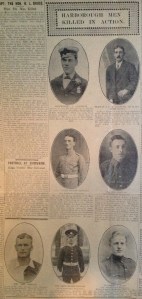
Seven young men killed in action are pictured on the final page of the final edition of the Market Harborough Advertiser of 1914
The ringing of bells at midnight on December 31 always heralds a spirit of hope and optimism for the New Year and that view is echoed even more poignantly in the final Editor’s Column of 1914 in the Market Harborough Advertiser.
“1914 bequeaths a legacy of world-wide strife to its successor and 1915 will prove one of the most momentous years in the history of mankind,” says the editorial.
“Our hope and prayer is that it may see the conclusion of the conflict that is devastating Europe and the dawn of long days of peace for all nations.
“The German offensive has in all essentials failed. The maximum force of all the Prussian military machine has been brought to bear without effecting the confidently anticipated result. Germany’s resources have been used to the full, her great opportunity has come and gone.
“In the belief that 1915 will take the course that we have foreshadowed we are able to greet our readers with the old familiar wish for A Prosperous New Year.”
With a hundred years of hindsight we can understand why there was such optimism and how sad that now seems as many millions of men, women and children were destined to die or have their lives shattered by a conflict that would go on for nearly four more long years.
The newspaper – now only six pages instead of the eight that accommodated a huge influx of December advertising – reflects on a Christmas Day that dawned with ‘a sharp, white frost’.
“Fields and gardens were white under its spell and the trees and hedgerows were beautiful beyond description. Dickens has given us wonderful pictures of what we refer to now as a ‘good old-fashioned Christmas’ snow and ice predominating, but that which greeted us on Christmas Day would be hard to beat.”
However in many homes across the area they would have been grieving for loved ones lost. And the Advertiser is keen to pay its respects by reproducing the photographs of young Market Harborough area men who died in action during the conflict.
There were seven. By December 1915 the death toll would be much larger.
- Check out this week’s Harborough Mail for current news from the Market Harborough area.
- My fellow researcher and De Montfort University colleague David Penman is conducting a similar real-time project with the Ashbourne Telegraph. Check out his Great War Reports.